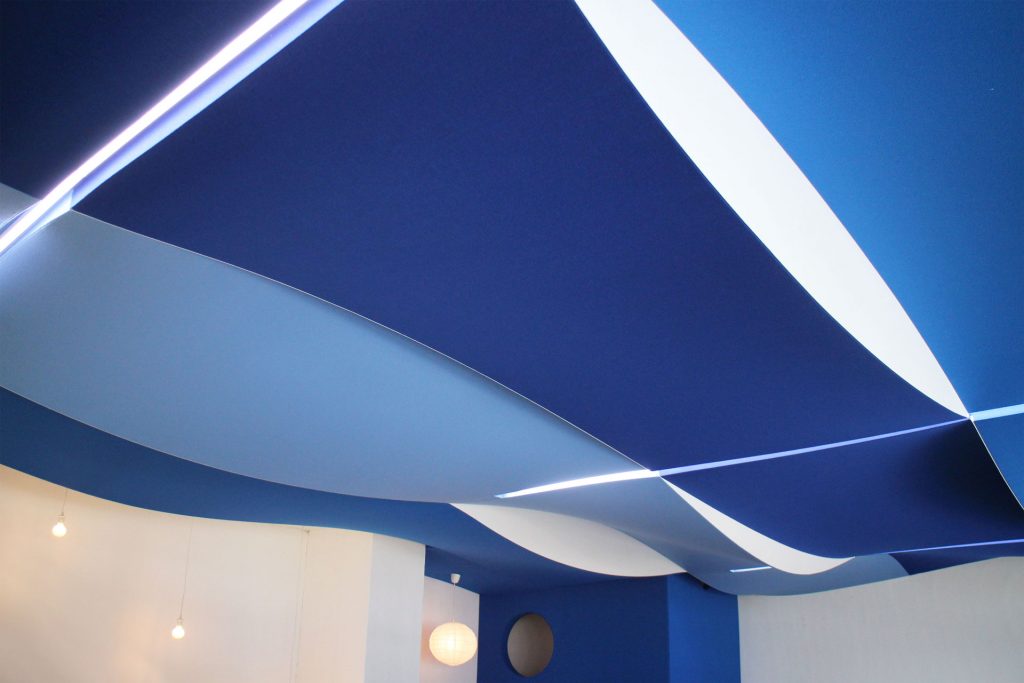
AntiCAD’s architectural innovation, the Great Wave Project, pays tribute to one of the most iconic pieces of Japanese art: The Great Wave Off Kanagawa by Katsushika Hokusai. This project transforms ceiling architecture through a dynamic installation of Fabrix™ panels, using computational design to recreate the fluid motion of ocean waves. By integrating parametric designs, Grasshopper Rhino modeling, and DFMA (Design for Manufacturing and Assembly), AntiCAD merges aesthetics with acoustic performance in an office environment. Inspired by architectural pioneers like Zaha Hadid and Arturo Tedeschi, this kinetic structure embodies the fusion of digital fabrication, traditional craftsmanship, and modern sustainability.
The Parametric Vision Behind the Great Wave Project
At the heart of the Great Wave Project is a commitment to parametric design. AntiCAD has leveraged computational design methodologies to generate an intricate ceiling system that mimics the undulating motion of water. By using Rhino 3D and Grasshopper Rhino, the team developed a set of rules that govern the wave-like pattern, ensuring precision in curvature, panel spacing, and acoustic performance. This approach ensures precision in curvature and panel spacing, making it perfectly suited for the interior of the office it was designed for.
Fabrix™, AntiCAD’s parametric fabric system, plays a crucial role in bringing this vision to life. Designed for both aesthetic and acoustic enhancement, the system uses low VOC materials that contribute to sustainable architecture. The fabric panels, suspended in a flowing sequence, create an immersive environment that softens noise while maintaining a visually striking ceiling. Through DFMA principles, AntiCAD has optimized the fabrication and installation process, ensuring cost-effective and efficient production while focusing on creating a visual dynamism and acoustic effectiveness, ensuring that the wave-like design enhances the office space’s atmosphere and functionality.

Core Innovations of the Great Wave Project
The Great Wave Project integrates multiple design and technological elements that make it a standout in modern ceiling architecture.
Parametric Fabric Systems for Acoustic Optimization
Fabrix™ is engineered to enhance sound absorption while maintaining aesthetic fluidity. Its parametrically designed curvature ensures optimal acoustic performance by diffusing and absorbing sound waves in an office environment. This technology is particularly beneficial for open-plan workspaces where noise control is essential.
Unlike traditional ceiling panels, Fabrix™ offers flexibility in form and function. Using Rhino 3D modeling and computational design, the system can be adjusted in real-time to fit different ceiling layouts. The fluid nature of the installation allows for seamless integration with lighting, ventilation, and other architectural elements.
Sculptural Ceilings for Immersive Interiors
The Great Wave Project transforms ceiling design into a sculptural experience, drawing inspiration from the rhythmic movement of ocean waves. The undulating Fabrix™ panels create a striking visual effect, enhancing the spatial atmosphere of the office while also serving an acoustic function.
By using parametric design, the ceiling installation achieves precision in curvature and seamless integration with existing architectural elements. The carefully calculated panel arrangement ensures both an immersive aesthetic and optimized sound absorption. The result is a ceiling that embodies motion and depth, capturing the fluidity of Hokusai’s famous wave in a modern, functional setting.
Sustainable and Low VOC Materials
Environmental consciousness plays a central role in the Great Wave Project. Fabrix™ panels are made using low VOC materials that meet contemporary sustainability standards. This approach aligns with the industry’s increasing demand for green construction techniques, reducing indoor air pollutants and creating healthier workspaces.
Additionally, by employing DFMA principles and 3D printing construction materials, AntiCAD has minimized production waste while optimizing resource efficiency. The result is an eco-friendly installation that contributes to both aesthetic and environmental sustainability.

The Future of Parametric Fabric Installations
As parametric facade architecture continues to evolve, projects like the Great Wave Project demonstrate the potential of computational design in transforming interior spaces. The integration of architecture augmented reality (AR) could even further enhance customization, allowing designers to visualize and modify parametric structures in real time.
Architecture AR for Interactive Design
With architecture AR, designers and clients can interact with parametric fabric systems before installation. This real-time visualization enhances precision and allows for last-minute refinements to acoustic performance and aesthetics.
IoT-Enabled Smart Ceilings
Future iterations of Fabrix™ could incorporate IoT for smart building applications. By embedding responsive technologies, kinetic structures could dynamically adjust based on sound levels, occupancy, and environmental conditions.
Expanding Parametric Fabric Systems
The use of parametric fabric ceilings could extend beyond office spaces into public venues, galleries, and educational institutions. The combination of acoustic performance and kinetic adaptability makes this system a compelling solution for large, open areas.
Enhanced Fabrication with 3D Printing
With advancements in 3D printing construction materials, the fabrication of parametric facades and kinetic ceiling systems could become even more precise and cost-effective. Digital manufacturing techniques will continue to refine and push the boundaries of architectural applications.

The Great Wave of Architectural Innovation
The Great Wave Project exemplifies AntiCAD’s ability to merge parametric designs with architectural artistry. By using Fabrix™, the installation achieves both visual dynamism and acoustic efficiency, redefining how ceilings can function as both aesthetic and practical elements within a space. The application of Rhino 3D and Grasshopper Rhino ensures a seamless integration of computational design principles, while DFMA streamlines production and assembly.
Inspired by the kinetic elegance of natural waves and the precision of digital fabrication, the Great Wave Project is a testament to the evolving relationship between art and architecture. Whether in office spaces, cultural institutions, or commercial venues, this project highlights the potential of kinetic buildings, sustainable materials, and parametric facade designs in shaping the future of interior environments. With AntiCAD’s expertise in computational design and innovative fabrication, the future of architectural ceilings is set to be as fluid and powerful as the ocean itself.
References
- AntiCAD’s Fabrix™: https://anticad.com/fabrix/
- The Great Wave project video: https://www.youtube.com/watch?v=wNrU9uuBMlE
Autodesk. (n.d.). What is parametric design in architecture? Fusion Blog. Retrieved from https://www.autodesk.com/products/fusion-360/blog/parametric-design-architecture-shaping-industry/
Architizer. (2023, May 15). Architecture 101: What is parametric architecture? Architizer Journal. Retrieved from https://architizer.com/blog/practice/details/architecture-101-what-is-parametric-architecture/
Share